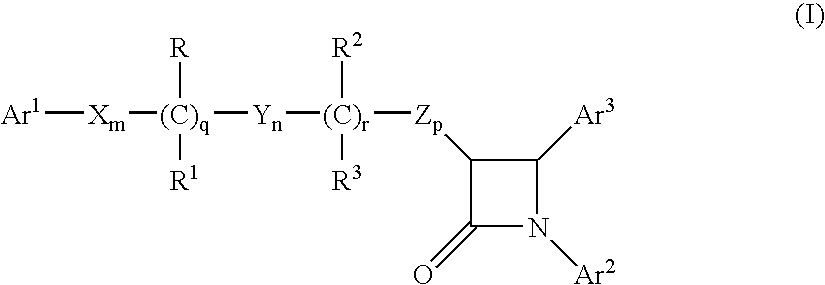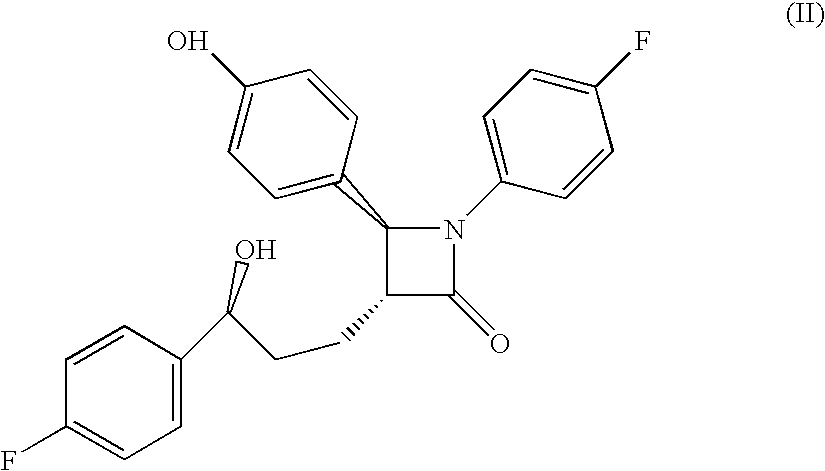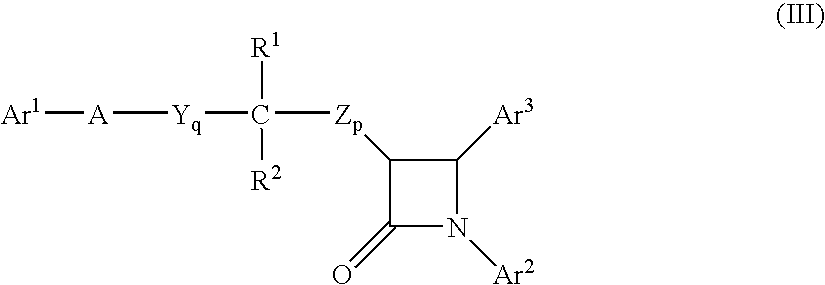Combinations of bile acid sequestrant(s) and sterol absorption inhibitor(s) and treatments for vascular indications
a technology of sterol absorption inhibitor and bile acid sequestrant, which is applied in the direction of drug composition, extracellular fluid disorder, metabolic disorder, etc., can solve the problem of significant elevation of the risk of chd
- Summary
- Abstract
- Description
- Claims
- Application Information
AI Technical Summary
Benefits of technology
Problems solved by technology
Method used
Image
Examples
example 1
[0559]To follow the movement of lipids across the intestinal wall leading to its subsequent appearance in the lymph, blood and liver, a short term hamster model which tracked a bolus of gavaged radiolabeled lipid was used. Free cholesterol absorption was examined in this hamster model to explore whether the cholesterol absorption inhibitor compound of Formula (XII):
in combination with the bile acid sequestrant cholestyramine would have additive efficacy. Compound XII can be prepared as shown in Example 9 of U.S. Pat. No. 5,688,787, which is incorporated by reference herein.
[0560]Male Golden Syrian hamsters were fed a diet containing 0.5% cholesterol overnight and divided into groups of 5 animals. In the morning they were gavaged with 1 uCi of [14C]-cholesterol with 1 mg of unlabelled cholesterol (NEN / Dupont) in 0.2 ml of corn oil, one hour after they were gavaged with corn oil as a Control, compound of Formula (XII) (3 mg / kg of body weight), cholestyramine (1 g / kg of body weight), o...
example 2
Preparation of Compound of Formula (II)
[0562]Step 1): To a solution of (S)-4-phenyl-2-oxazolidinone (41 g, 0.25 mol) in CH2Cl2 (200 ml), was added 4-dimethylaminopyridine (2.5 g, 0.02 mol) and triethylamine (84.7 ml, 0.61 mol) and the reaction mixture was cooled to 0° C. Methyl-4-(chloroformyl)butyrate (50 g, 0.3 mol) was added as a solution in CH2Cl2 (375 ml) dropwise over 1 h, and the reaction was allowed to warm to 22° C. After 17 h, water and H2SO4 (2N, 100 ml), was added the layers were separated, and the organic layer was washed sequentially with NaOH (10%), NaCl (sat'd) and water. The organic layer was dried over MgSO4 and concentrated to obtain a semicrystalline product.
[0563]Step 2): To a solution of TiCl4 (18.2 ml, 0.165 mol) in CH2Cl2 (600 ml) at 0° C., was added titanium isopropoxide (16.5 ml, 0.055 mol). After 15 min, the product of Step 1 (49.0 g, 0.17 mol) was added as a solution in CH2Cl2 (100 ml). After 5 min., diisopropylethylamine (DIPEA) (65.2 ml, 0.37 mol) was a...
PUM
| Property | Measurement | Unit |
|---|---|---|
| Mass | aaaaa | aaaaa |
| Mass | aaaaa | aaaaa |
| Concentration | aaaaa | aaaaa |
Abstract
Description
Claims
Application Information
 Login to View More
Login to View More - R&D
- Intellectual Property
- Life Sciences
- Materials
- Tech Scout
- Unparalleled Data Quality
- Higher Quality Content
- 60% Fewer Hallucinations
Browse by: Latest US Patents, China's latest patents, Technical Efficacy Thesaurus, Application Domain, Technology Topic, Popular Technical Reports.
© 2025 PatSnap. All rights reserved.Legal|Privacy policy|Modern Slavery Act Transparency Statement|Sitemap|About US| Contact US: help@patsnap.com



